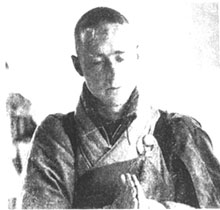What
was the reason for the pilgrimage? It would remind people that it is not a
peaceful world; that while most of us go about fairly oblivious, enjoying
what pleasure we can, there are others making weapons—improved weapons,
smarter weapons, weapons which before long will be able to set themselves
off. When that happens, one will trigger another and a great roar will
well up: "Kill! Kill! Kill!"
These
weapons are fierce; they can annihilate the entire world. The bowing
journey is to awaken the people to this madness—that the missiles are
coming. And to encourage people
everywhere to seek peace in their own way, sincerely.
As
the concept of the pilgrimage formalized in Heng Sure's mind he thought:
"The attitude that will carry us through is a sense of shame and a
sense of sameness with all. It will be a compassionate regard for the
suffering of all living things that must die again and suffer again. It
will be the constant awareness that it will be my own hard work, which
will carry the practice through to completion. The pilgrimage is a
process, a path, done before, to do again. I must push myself to the
limit—expand my state through practice. I don't know how far I can so
until I do. Beyond
reckoning..."
On
Tuesday, September 7th, Heng Sure went before the Buddhas, Bodhisattvas,
the Venerable Master and the Great Assembly to formalize his vow to make
this bowing pilgrimage. His purpose was three-fold:
1)
To seek for world peace.
2)
To repay the kindness of his teacher.
3)
To repent and reform of his bad karma from past, present, and future.
And
the transference of merit from this practice was all to go "to the
establishment of the City of Ten Thousand Buddhas, that it might be
quickly and easily accomplished."
Emphasizing
this point Heng Sure noted: "It is clear that to insure the
establishment of this great Bodhimanda will take a real sacrifice on the
part of many people. If someone has to die literally or figuratively to
accomplish this project, let it be me."
On
October 10, 1976, the third phase of the precept platform was completed
with the administering of the Bodhisattva precepts. Then began the
training period for Heng Sure during which he practiced bowing once every
three steps for hours around the Buddha-hall of Gold Mountain and also
carried on must of the administrative duties of the monastery.
In
December it turned cold and he envisioned himself suffering in the cold
with nowhere to go for shelter but his own mind. No light, no roof, no hot
water, no front door. And he thought, "One sure for the trials to
come: don’t go sideways to improve or to change the situation; don't
look for relief in physical pleasure. Keep it clean and you will reap the
benefits of directed energy.'
His
training continued and on April 5th, 1977, he noted, "This morning I
rediscovered the importance of focusing my eyes for concentration. Eyes
focused on my nose, I will he able to enter samadhi. Tongue on the roof of
my mouth and breath light and regular, everything else falls into right
perspective and I can be mindful. I can turn every waking moment into
meditation!' On May 7th, 1977, the pilgrimage actually began.
Now
in their tenth month of bowing, the monks have experienced an
ever-deepening level of cultivation. Their experiences serve as lessons,
as motivation to work even harder, and as evidence of the unfailing power
of faith, vows and practice. Vajra Bodhi Sea prints excerpts from their
records and letters and with One Heart, Bowing to the City of Ten Thousand
Buddhas, Volume I, the first in a series of their daily records, letters,
news articles, and photographs of the extraordinary pilgrimage, is now
available from the Buddhist Text Translation Society.
-----------------------------------------------
THE
EARTH STORE BODHISATTVA SUTRA, the Sutra of Filial Piety which Sakyamuni
Buddha spoke in the Trayastrimsha Heaven for the sake of his mother, the
Lady Maya. This Sutra is an invaluable means to rescue the sick, dying,
and deceased—to relieve suffering, bring better rebirth, eradicate of
tenses. It can be recited by expectant mothers, by the relatives of those
in peril who cannot recite for themselves, by children to help their
parents, by parents to help their children. Each recitation brings merit
to the one reciting and to those recited for Available in English from the
Buddhist Text Translation Society. |
